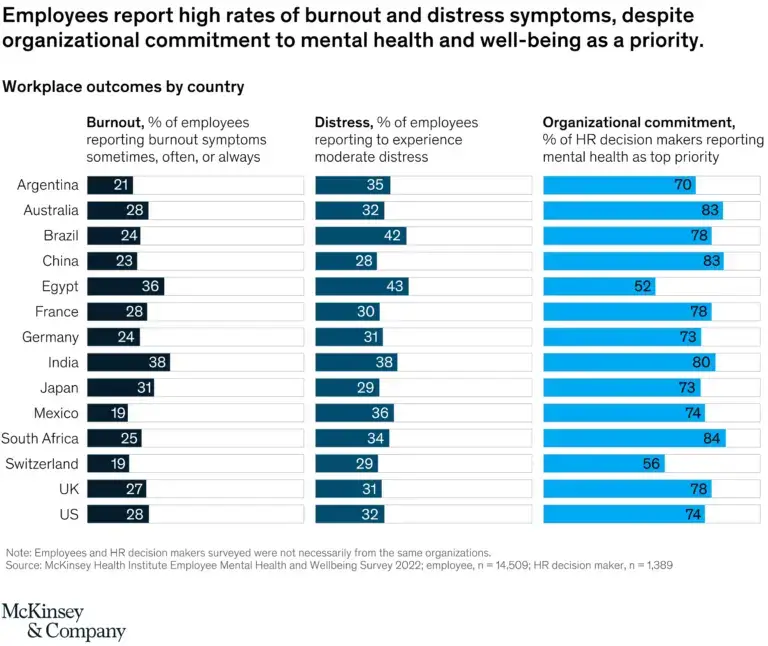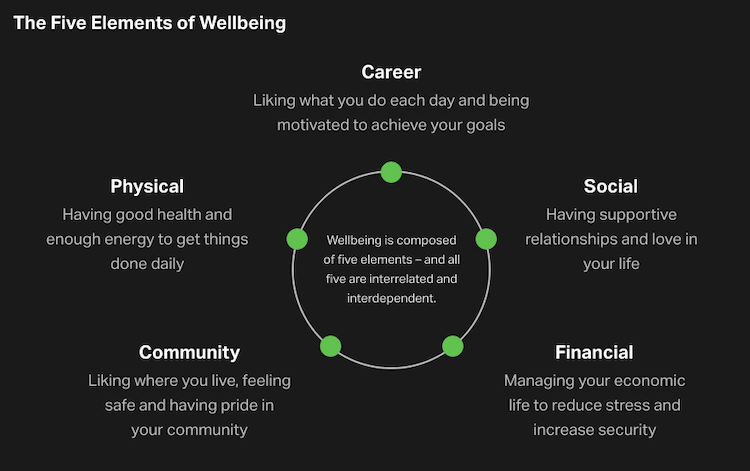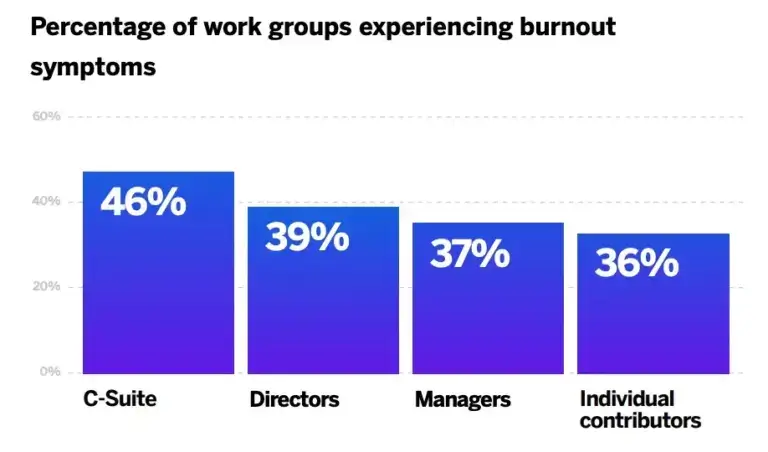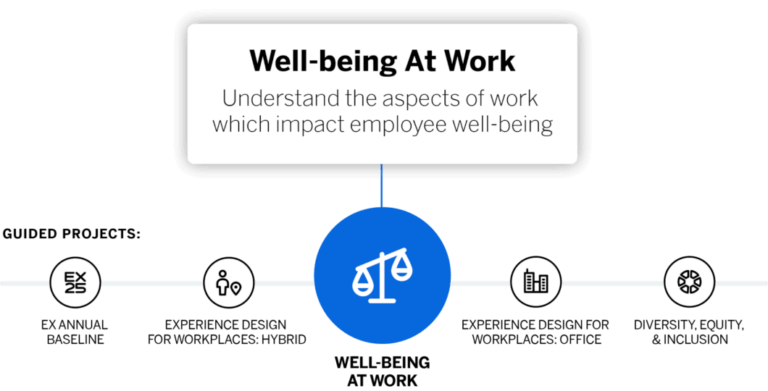What is employee burnout?
Employee burnout is an unpleasant mixture of work stress, exhaustion, and negative, cynical feelings. It’s closely connected to our job and our workplace, and the World Health Organisation recognises and defines this ‘occupational phenomenon’ as follows:
Burn-out is a syndrome conceptualised as resulting from chronic workplace stress that has not been successfully managed. It is characterised by three dimensions:
- feelings of energy depletion or exhaustion;
- increased mental distance from one’s job, or feelings of negativism or cynicism related to one’s job; and
- reduced professional efficacy.
A study by McKinsey of nearly 15,000 workers across 15 countries found that, on average, a quarter of employees report experiencing symptoms of burnout – despite HR professionals making employee mental health a top priority:

Image from Mckinsey
Our own 2023 Employee Experience Trends Report found that more than a third (38%) of employees feel they’re burnt out. We also discovered that the top driver of burnout this year is ineffective processes and systems. More on this later.
Employee burnout used to be viewed as a workers’ problem: if you were going to make a success of your career in the rat race, you had to manage your own mental health, self-care, and work-life balance to cope with whatever the job and your managers decided to throw at you.
Increasingly, though, employee burnout is considered a problem with the company, not the workers, and it’s up to everybody in an organization – leaders, managers, and employees themselves to speak up and address the issue.
Start listening to your employees with our free survey software
What are the signs of employee burnout?
Leaders and managers, and employees themselves need to look out for these signs of employee burnout in their teams:
- Increase in absenteeism
- Decrease in productivity
- Making more mistakes
- Difficulty remembering things
- Unmotivated and unenthusiastic about the job
- Poor decision-making
- Irritability and overly sensitive to feedback
- Cynical and negative attitude
- Exhaustion due to difficulty sleeping
- Lack of interest in workplace culture
If you notice any of these signs in yourself or your colleagues, it’s important to seek help and support. Burnout can have wide-ranging negative consequences for employees’ health, well-being, career – and the organization itself.
What causes employee burnout?
Bad processes and inefficient systems
While the pandemic relied on digital transformation and new technologies to support new ways of working, it also surfaced glaring inadequacies in many existing legacy processes and presented new challenges. Many employees had tolerated these system and process inefficiencies for years, and as a result, almost 4 in 10 feel burnt out and less productive than they’ve ever been.
Unmanageable workload
Chronic overloading, with perhaps being urged to work faster, results in: not being able to get work done effectively, and having little time for leisure and relaxation, or even career growth and development, which is unsustainable for any length of time.
Lack of control or autonomy
Feeling out of control of your work: timescales, schedules, workload, projects, resources and even decisions that affect your career and professional life, can all contribute to burnout. Without full job ownership, employees struggle to schedule, time-manage and deliver satisfactory work outcomes.
Micromanagement
Bound up with employees’ lack of control, micromanagement is a manager behavior characterized by excessive supervision, controlling employees’ work and how they do it, and a reluctance to delegate or allow their team to make their own decisions.
A toxic workplace culture
A culture that does not stamp out bullying, gossip, oppressive behavior (sexism, racism, homophobia, etc.), office politics, and general unfair treatment leads to people feeling psychologically unsafe. Psychological safety is essential for employees to be able to thrive in an organization and do their best work.
Unclear job expectations and lack of support
Unsupportive line managers, leaders, and co-workers lead to confusion, uncertainty, frustration and apathy.
Lack of work-life balance
Long hours and weekend working, always-on email and messaging encroach into personal life. No respite from work leads to burnout.
Being forced to come back into the office
Many people found working from home during and post-pandemic gave them greater work life balance and more time for family and leisure. Being forced back on a commute, working in an office environment and having to juggle caregiving responsibilities once more is enough to burn out some employees.
Reward
When employees feel the work they put in, maybe ‘going above and beyond’ for the organization doesn’t match the recognition and rewards given, this lack of appreciation may lead to burnout.
Too many meetings
While collaborative working can be great for innovation and creativity, too many meetings, reports, brainstorming sessions, and presentations can overwhelm workers who just want to quietly get on with their current task at hand in their own sweet time.
Poor time management
Setting unrealistic deadlines; over- or under-estimating the time needed to do tasks and failing to appreciate the pace at which each employee works can put time stress onto your teams.
Overloading the ‘stars’
The saying, ‘If you want to get the job done, ask a busy person’ means that the most capable employees are given the most work. It’s a mistake to overestimate the amount of work you think your team members can handle, and just because talented employees can work three times as fast as their co-workers, this doesn’t mean you can give them three times as many tasks.
The effects of employee burnout
Nobody benefits from overworking and burning out employees.
- For the employees themselves: At the very least, burnout leaves employees disengaged, disinterested, and performing poorly. More seriously, overwork and burnout can exact a terrible toll on people’s physical and mental health. Emotional exhaustion, anxiety, depression, addiction, sleep problems, gastrointestinal conditions, headaches, workplace accidents, and even serious health conditions such as cardiovascular disease and Type 2 diabetes can be linked to chronic stress at work.
- For the business: Every aspect of employee burnout – absenteeism, poor performance, decreased productivity, health issues, higher healthcare costs, accidents, talent attrition, and re-recruitment affects the bottom line, and can even go further into brand reputational damage and legal claims.
How can you alleviate employee burnout?
When LinkedIn, Hootsuite, and Bumble gave all their employees a week off in summer 2021 to fight ‘Covid burnout’, they made headlines around the world as caring companies who recognised the toll of overwork and classic burnout on their people. But interestingly, fewer than half of employees feel that taking time off alleviates their feelings of burnout. And as Christina Maslach, a social psychologist, observes, “If the best thing you can do for your employees is to tell them not to come to work, what is wrong with the work?”
It seems that the answer to fixing employee burnout is ‘fix the work’. So how can you do that, and create an employee-centric culture?
Put wellbeing at the heart of your workplace

Image from Gallup
When an organisation embeds wellbeing into its culture as the norm, rather than as a ‘nice-to-have’ on a human resources checklist, employees are more inclined to take good care of their physical and mental health and speak up when something’s not right. An organisation can incorporate all five elements of wellbeing, and by doing so, the management of burnout follows along naturally:
- Career – liking what you do each day and being motivated to achieve your goals: Managers can help this happen by apportioning tasks fairly to every member of the team so that everyone gets tasks that interest and develop them, and give them job satisfaction. Well-trained managers will be able to motivate team members towards shared goals.
- Social – having supportive relationships and love in your life: Fostering a workplace culture that is diverse and inclusive, with bonded, supportive teams.
- Financial – managing your economic life to reduce stress and increase security: Employees receive good pay and benefits for the work they do, perhaps with an employee assistance program, and feel contractually safe in their jobs.
- Community – liking where you live, feeling safe, and having pride in your community: A safe, pleasant working environment that everyone feels proud to work in.
- Physical – Having good health and enough energy to get things done daily: Healthcare plans, gym subscriptions, work sports clubs, exercise classes for mind and body, breaks to get out into the fresh air.
Help managers identify burnout risks
Our 2023 Employee Experience Trends Report found that it’s not just employees who are feeling burnt out. Globally, leaders are feeling the strain, too; almost half of C-suite executives reported burnout symptoms:

Experiencing burnout is the only area where C-suite and directors scored worse than individual contributors and managers.
Clearly, there’s currently a gap in the employee experience. Although organizations regularly ask for employee feedback, we found only 45% of employees strongly agree/agree with the statement: “I was given an opportunity to discuss the results from last year’s survey.”
The most impactful action organizations can take to rectify burnout as a consequence of poor processes is not simply to listen to employees, but to act on their feedback.
Where traditional management went for a ‘command-and-control’ dictatorial style that caused harmful work stress, making modern managers (who may be at risk of burnout themselves) aware of burnout risks changes that whole dynamic.
As a manager, you need to:
- Act on the results of an employee wellbeing survey, or other engagement survey, to show how you support employees and their well-being
- Organize team-building exercises and monthly catch ups to develop camaraderie and connections outside work
- Deliver information in good time
- Work to overcome difficult working conditions in busy periods, or here’s a failure in systems and processes
- Listen to team members who say they are burnt out after going above and beyond consistently
- Be flexible with employee metric ratings to help reduce performance stress
- Focus on employee well-being, staff morale, and resource availability to relieve people and avoid them working excessive hours
- Model behavior – don’t work through lunch or on vacation, or not take PTO, as this encourages employees to do the same
Make systems and processes efficient
We mentioned above that we found ineffective processes and systems to be the top driver of burnout this year. Employees are often being asked to do more with less, but without the appropriate systems and processes in place to work efficiently, organizations will continue to propagate employee burnout.
Be innovative and upgrade work processes to get ahead of competitors rather than fall behind. When you remove these obstacles, you empower your people, and make their jobs easier.
Make mental health a priority
Job burnout results from the work-related stress of an overwhelming workload, inflexibility, lack of direction and clarity, micromanagement, and unfair treatment. These all affect employees’ mental health and can lead to mental illness, breakdowns and staff turnover.
Devise a mental health strategy that:
- Employees know about and trust
- Gives employees control of their schedule, within flexible, set boundaries
- Helps mitigate stressful workloads
- Offers an employee assistance program (EAP)
- Encourages employees to take ‘headspace’ breaks throughout the day
- Offers meditation/mindfulness/yoga sessions
- Makes everyone take all their vacation days
- Offers a safe space for expressing emotion, concerns or worries about work
Encourages open and transparent two-way communication
What employees can do to avoid burnout
Our 2023 Employee Experience Trends Report found that employees have been working at surge levels for years, and going ‘above and beyond’ at work had become the expectation of organizations rather than the exception. Now, employees have had enough, they’re pushing back, and reshaping the relationship they have with work.
Employees can:
Reclaim healthy boundaries between work and personal life
For example, by switching off work phones and laptops in personal time or during vacations.
Ask to work flexibly
Choose the working hours that suit them and their whole life.
Manage workload and priorities proactively
Give feedback that communicates what they expect and need to their manager and team to do when managing workload and priorities. Communicate those expectations and needs.
Ask for feedback and guidance
From their manager or team to identify areas of struggle and where they could develop their skills.
Check in on the team
Ask how their co-workers are doing, to make sure they’re not being overwhelmed – and they’ll do the same.
Sign up for wellness programs
Such as gym memberships, team sports and other resources offered by the organization.
Out of work, practice mind and body self-care
Do exercise, eat healthily, practice mindfulness or meditation, take care of sleep hygiene and have hobbies and interests.
Nurture a social support network
This can be friends, family and colleagues; people you can destress with, who’ll listen, empathize with you, laugh with you and give good advice.
How Qualtrics Well-being at Work solution can help prevent employee burnout
When you use our experience management platform, Qualtrics EmployeeXM, with our Well-being at Work solution built in, you’ll be able to gauge the emotional health of your employees, and pick up the first stages of workplace burnout, ready to take action immediately.

With our solution, you’ll be able to do many things such as:
- accelerate your well-being at work program with built-in, expert-designed survey questions
- integrate well-being at work into existing listening touchpoints, or run it as a standalone program
- help your HR team to roll out a comprehensive well-being program without additional costs
- evaluate employee and team well-being while preserving employee anonymity
- Use validated drivers, items and questions that are proven to make the most positive impact on well-being at work
- Provide every employee with their own report that recommends tips and actions to enhance well-being at work
Start listening to your employees with our free survey software